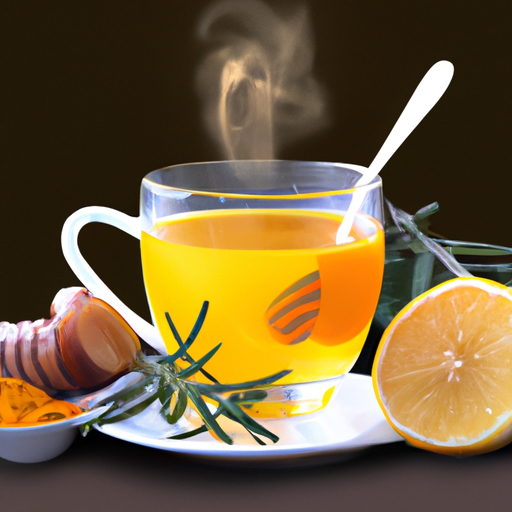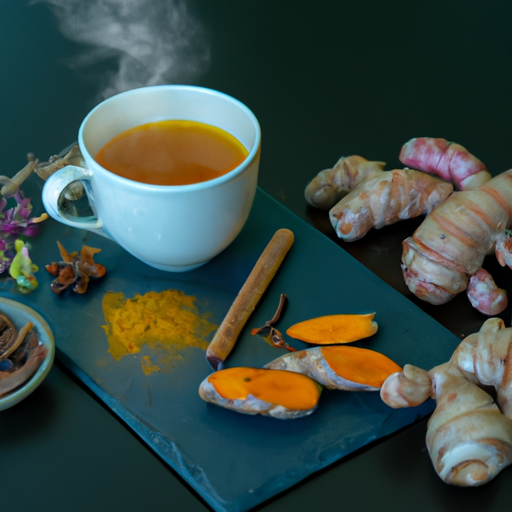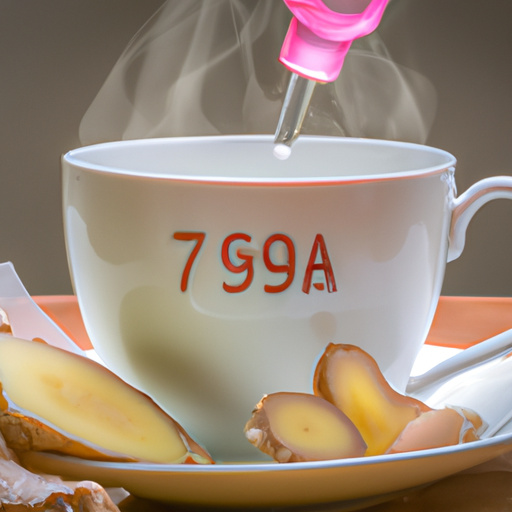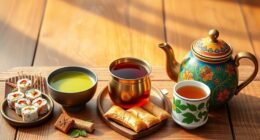I’ve been hearing a lot about the health benefits of turmeric and ginger tea recently. Many people claim that it can help reduce inflammation, aid digestion, and enhance the immune system. But are these assertions based on facts?
I decided to do some research and found that there is actually scientific evidence to support the use of turmeric and ginger for health purposes. Now that I had the facts, I was eager to try making my own turmeric and ginger tea.
I learned that it’s a simple process that only requires a few ingredients. Not only is it a great way to reap the health benefits of these spices, but it’s also a delicious and comforting beverage that’s perfect for any time of day.
In this article, I’ll share with you my step-by-step guide to making turmeric and ginger tea at home.
Key Takeaways
- Turmeric and ginger both have anti-inflammatory properties and are powerful antioxidants.
- Adding honey and lemon can provide additional antioxidants and flavor, while cinnamon, cardamom, and cloves offer health benefits and enhance flavor.
- Milk or cream can add nutrients and create a luscious texture, but too much sugar can negate health benefits.
- Properly straining the tea and refrigerating leftover tea in an airtight container can help preserve nutrients and keep the tea fresh for up to a week.
Gather Your Ingredients
You’re going to love the fragrant aroma of your kitchen as you gather the turmeric, ginger, honey, lemon, and boiling water for your delicious turmeric and ginger tea. These ingredients are easily accessible at any grocery store and are packed with health benefits.
If you’re unable to find fresh turmeric or ginger, you can substitute with powdered versions instead. Just make sure that they’re high quality and free from any additives.
Turmeric and ginger are well-known for their anti-inflammatory properties, making this tea a great option for those looking to soothe sore muscles or reduce inflammation in the body. Adding honey and lemon provides a boost of antioxidants while also enhancing the flavor of the tea.
Now that you have your ingredients, let’s move on to choosing your tea base.
Choose Your Tea Base
Feeling indecisive? Try picking a tea base that will ignite your taste buds and soothe your soul. There are many tea varieties that work well with turmeric and ginger, each offering unique and delicious flavor combinations. To help you decide, I’ve put together a table of some popular tea options and their flavor profiles when paired with turmeric and ginger.
| Tea Variety | Flavor Profile |
|---|---|
| Black Tea | Bold and robust, balances well with the spice of ginger and earthiness of turmeric |
| Green Tea | Light and fresh, pairs well with the warmth of ginger and slight bitterness of turmeric |
| Herbal Tea (such as chamomile or peppermint) | Soothing and calming, complements the spiciness of ginger and sweetness of turmeric |
| Rooibos Tea | Sweet and nutty, enhances the earthiness of turmeric and adds depth to the spiciness of ginger |
Once you’ve chosen your tea base, it’s time to prepare it for the perfect cup of turmeric and ginger tea.
Prepare Your Tea Base
Ready to enjoy your perfect cup of tea? Let’s start by preparing your chosen tea base. Whether you choose black tea, green tea, or herbal tea, the key to a great cup of turmeric and ginger tea is to brew the tea properly.
Tea brewing techniques vary depending on the type of tea you choose. Black tea, for example, should be brewed at boiling point for 3-5 minutes, while green tea should be brewed at a lower temperature for only 1-3 minutes. Herbal teas, on the other hand, can be brewed at a higher temperature for a longer period of time.
If you’re looking for an alternative tea base for your turmeric and ginger tea, you can try using rooibos tea or white tea. Rooibos tea has a sweet and nutty flavor that pairs well with the earthiness of turmeric and the spiciness of ginger. White tea, on the other hand, has a subtle and delicate flavor that allows the turmeric and ginger to shine.
No matter which tea base you choose, make sure to follow the brewing instructions carefully to get the best flavor and health benefits from your tea. Now that your tea base’s ready, it’s time to add your spices.
Add Your Spices
Now that I’ve got my tea base ready, it’s time to add in some spices for flavor and added health benefits.
First, I grate some fresh ginger and add it to the pot. Ginger has anti-inflammatory properties and can aid in digestion.
Next, I add in some turmeric, which has been shown to have powerful antioxidant effects.
Other spices to consider adding include cinnamon, cardamom, and black pepper for added flavor and health benefits.
Grate Ginger
To start making turmeric and ginger tea, simply grate some fresh ginger using a fine grater to release all of its aromatic oils and flavors. Ginger is not only a flavorful spice, but it also has numerous health benefits. It has anti-inflammatory properties that can reduce pain and swelling, and it can also help with digestion and nausea. Ginger can be used in many different ways in cooking, such as adding it to stir-fries, marinades, and baked goods.
When grating the ginger for your tea, aim for about 1-2 teaspoons of grated ginger per cup of water. To make it easier to measure, you can use a small tablespoon or a kitchen scale. Once you have grated the desired amount of ginger, add it to a small pot with water and bring it to a boil. But before we add the water, let’s talk about the benefits of turmeric and how to incorporate it into our tea.
Add Turmeric
You’ll want to add a pinch of ground turmeric to the pot once the water is boiling, as this spice not only adds a warm, earthy flavor to the tea but also has powerful anti-inflammatory and antioxidant properties that can benefit your health. Turmeric has been used for centuries in traditional medicine to treat various ailments, and modern research has confirmed many of these health benefits.
Here are three ways that adding turmeric to your tea can improve your wellbeing:
-
Reduces inflammation: Turmeric contains compounds called curcuminoids, which have anti-inflammatory effects that can help relieve pain and swelling in the body.
-
Boosts immunity: Turmeric is also rich in antioxidants, which protect your cells from damage caused by free radicals. This can strengthen your immune system and reduce your risk of chronic diseases.
-
Supports digestion: Turmeric has been shown to stimulate the production of bile, which helps break down fats and aids in digestion. This can reduce bloating, gas, and other digestive issues.
Now that you’ve added turmeric to your tea, you may be wondering what other spices you can include to enhance the flavor and health benefits.
Other Spices to Consider
As you sip your steaming cup, the warm, aromatic flavors of cinnamon, cardamom, and cloves can transport you to a cozy winter evening by the fireplace. These spices aren’t just delicious, they also offer numerous health benefits.
Combining turmeric and ginger with other natural remedies can further enhance their therapeutic properties. Turmeric and ginger are well-known for their anti-inflammatory and antioxidant effects. However, there are many more uses for these powerful herbs beyond tea.
Turmeric can be added to curries, soups, and smoothies, while ginger can be used in stir-fries and marinades. Both herbs can also be taken as supplements in capsule form. Combining turmeric and ginger with other natural remedies, such as honey and lemon, can provide additional health benefits and help to fight off colds and flu.
As you explore the many uses for turmeric and ginger, you may also want to consider adding a touch of sweetness to your tea. In the next section, we’ll discuss how to add a natural sweetener to your turmeric and ginger tea.
Add Sweetener
Now, if you have a sweet tooth, go ahead and add a teaspoon of honey or maple syrup to your turmeric and ginger tea for a touch of sweetness. Both honey and maple syrup are natural sweeteners that not only enhance the taste of your tea but also offer some health benefits.
Honey has anti-inflammatory properties, can help soothe a sore throat, and is a good source of antioxidants. On the other hand, maple syrup contains minerals such as manganese and zinc, and has a lower glycemic index than regular sugar, making it a better option for people with diabetes.
Adding a sweetener to your turmeric and ginger tea can make it more enjoyable to drink, but keep in mind that too much sugar can negate the health benefits of these spices. So, be mindful of how much sweetener you’re adding and opt for natural alternatives like honey or maple syrup.
Now, let’s move on to the next section where we discuss how to add milk or cream to your tea for a creamier texture.
Add Milk or Cream
To create a luscious and velvety texture, try adding a splash of creamy milk or rich cream to your golden elixir. Not only does it enhance the taste, but it also adds a boost of nutrients.
If you’re lactose intolerant or vegan, there are many milk alternatives you can use such as coconut, almond, or oat milk. These options also bring their own unique flavors to the tea, allowing you to experiment and find the perfect combination that suits your taste buds.
When it comes to sweeteners, adding milk can tone down the intensity of the spices, making it less necessary to add sugar or honey. However, if you prefer your tea on the sweeter side, try experimenting with different sweeteners such as maple syrup, agave, or stevia.
Just be mindful of the amount you use, as these sweeteners can still add calories and affect blood sugar levels. Now that we’ve added milk and sweetener, it’s time to strain the tea to remove any remaining bits of ginger or turmeric.
Strain the Tea
Adding milk or cream to your turmeric and ginger tea can help to soften the flavors and add a creamy texture to the drink. However, before enjoying your tea, it is important to strain it properly to remove any bits of ginger or turmeric that may have been left behind during the brewing process.
There are several different techniques for straining tea, but one of the easiest is to use a fine mesh strainer. Simply place the strainer over your tea cup or mug and carefully pour the tea through it. If you prefer a smoother texture, you can use a cheesecloth or coffee filter to strain the tea. Once your tea is strained, you can enjoy it as is or experiment with different tea blends to create your own unique flavor combinations. For example, adding a green tea bag to your turmeric and ginger tea can provide an extra boost of antioxidants and a subtle, grassy flavor.
Now that your tea is strained and ready to go, it’s time to serve and enjoy!
Serve and Enjoy
Indulge in a moment of pure bliss as you savor the warm, creamy texture and vibrant flavor of your freshly brewed turmeric and ginger tea. Now that your tea is perfectly steeped and strained, it’s time to sit back, relax, and enjoy.
Here are a few tips to enhance your tea time etiquette and make the most out of your experience:
-
Pair with snacks: Tea time is the perfect opportunity to indulge in a few snacks. The warm, spicy flavors of turmeric and ginger tea pair well with sweet or savory treats such as cookies, cakes, or even cheese and crackers. Choose your favorite snack and savor each bite in between sips of your tea.
-
Variations for different tastes: If you want to experiment with different flavors, try adding a splash of honey or a slice of lemon to your tea. You can also add a pinch of cinnamon or nutmeg for a cozy, warm flavor. Get creative and find the perfect blend of flavors that suits your taste buds.
-
Experimenting with flavors: If you want to take your tea to the next level, try adding other herbs or spices to your brew. Mint, chamomile, or even cardamom can add a unique twist to your turmeric and ginger tea. Don’t be afraid to experiment and find your perfect blend.
Now that you’ve enjoyed your tea to the fullest, it’s time to store any leftovers for later.
Store Leftovers
Now that I’ve enjoyed my delicious turmeric and ginger tea, it’s important to know how to store any leftovers properly.
The two key things to keep in mind are refrigeration and reheating. It’s essential to refrigerate any leftover tea immediately and store it in an airtight container in the fridge to prevent bacteria growth.
When reheating, make sure to do so thoroughly to ensure that any harmful bacteria are killed off and the tea is safe to consume.
By following these simple steps, we can enjoy our turmeric and ginger tea without any risk to our health.
Refrigeration
To keep your turmeric and ginger tea fresh and flavorful, simply pop it in the fridge and let it chill until you’re ready to enjoy it.
There are several benefits of refrigerating turmeric and ginger tea. For one, the cold temperature helps to preserve the nutrients and antioxidants in the tea. Additionally, turmeric and ginger both have strong flavors that can become overpowering when served hot. However, when served cold, the flavors are more mild and refreshing, making for a perfect summer drink.
When you’re ready to enjoy your chilled turmeric and ginger tea, simply take it out of the fridge and give it a quick stir. If you prefer your tea warm, you can easily reheat it in the microwave or on the stovetop. But, if you’re looking for a refreshing beverage to cool you down on a hot day, serving it cold is the way to go.
Reheating
If you’re craving a warm and comforting beverage, simply reheat your chilled turmeric and ginger tea for a delightful treat. But before reheating, it’s important to consider the shelf life of your tea. While turmeric and ginger tea can last up to a week in the fridge, it’s important to check for any signs of spoilage before consuming. If the tea smells off or has an unusual taste, it’s best to discard it.
To reheat your turmeric and ginger tea, simply pour it into a saucepan and heat it on low heat until it reaches your desired temperature. Avoid boiling the tea as this can destroy the beneficial compounds. Once heated, you can add a touch of honey or lemon to enhance the flavor.
Enjoy your warm and comforting cup of turmeric and ginger tea anytime of the day!
Now, let’s move on to the health benefits of turmeric and ginger tea.
Health Benefits of Turmeric and Ginger Tea
I absolutely love drinking turmeric and ginger tea, not just because it’s delicious but also because it has numerous health benefits.
Firstly, both turmeric and ginger have anti-inflammatory properties which can help reduce inflammation in the body and alleviate pain.
Secondly, they’re both powerful antioxidants which can help protect the body from damage caused by free radicals.
Finally, drinking turmeric and ginger tea can also aid in digestion and soothe an upset stomach.
Anti-Inflammatory Properties
The anti-inflammatory properties of turmeric and ginger make this tea a great addition to your daily routine. Not only do these two ingredients add a delicious flavor to your tea, but they also provide numerous health benefits.
Turmeric contains a compound called curcumin, which has been shown to reduce inflammation in the body. Ginger, on the other hand, has compounds called gingerols and shogaols, which have similar anti-inflammatory effects.
To further emphasize the anti-inflammatory benefits of turmeric and ginger tea, here are four key points to keep in mind:
- Chronic inflammation can lead to a range of health issues, including heart disease, cancer, and arthritis.
- The anti-inflammatory properties of turmeric and ginger can help reduce joint pain and stiffness in individuals with osteoarthritis.
- The combination of turmeric and ginger has been shown to be more effective at reducing inflammation compared to either ingredient alone.
- Consuming turmeric and ginger regularly may also help improve digestion and boost immune function.
Now, let’s move on to the next section where we’ll discuss the antioxidant properties of this delicious tea.
Antioxidant Properties
Loaded with powerful antioxidants, this delicious blend of spices can help protect your cells from damage caused by harmful free radicals. Turmeric and ginger both contain compounds that have antioxidant properties, such as curcumin and gingerol. Antioxidants are substances that can prevent or slow cell damage caused by oxidative stress, which can lead to chronic diseases like cancer, heart disease, and diabetes.
Aside from their antioxidant properties, turmeric and ginger have many uses in cooking and skincare. Turmeric is commonly used in Indian and Middle Eastern cuisine to add flavor and color to dishes. It can also be used as a natural dye for fabrics and cosmetics. Ginger has been used in traditional medicine for centuries to treat nausea, inflammation, and respiratory infections. It is also used in skincare products for its anti-inflammatory and antibacterial properties.
As a digestive aid, turmeric and ginger tea can help reduce bloating, gas, and indigestion. In the next section, I’ll discuss the benefits of this tea for digestive health.
Digestive Aid
Packed with digestive benefits, this spicy blend can soothe stomach discomfort and promote healthy digestion. If you’re looking for natural remedies to alleviate common digestive issues, turmeric and ginger tea could be an herbal supplement worth trying.
Here are some of the ways that this tea can aid your digestive system:
-
Reduces inflammation: Both turmeric and ginger contain compounds that have anti-inflammatory properties. Inflammation in the digestive system can cause discomfort and pain, and these herbs can help to reduce that inflammation.
-
Stimulates bile production: Bile is an important part of the digestion process, as it helps to break down fats and absorb nutrients. Ginger has been shown to stimulate bile production, making it easier for your body to digest fatty foods.
-
Relieves nausea: Ginger is well-known for its ability to soothe nausea and vomiting. This makes it a great choice if you’re feeling queasy or have an upset stomach.
-
Improves gut health: Turmeric has been shown to improve gut health by increasing the growth of beneficial gut bacteria. A healthy gut microbiome is essential for proper digestion and overall health.
By incorporating turmeric and ginger tea into your daily routine, you can enjoy these digestive benefits and support your body’s natural processes. Plus, it’s a delicious and warming drink that can be enjoyed any time of day.
Frequently Asked Questions
What are the potential side effects of consuming too much turmeric and ginger tea?
Too much turmeric and ginger tea can cause stomach upset and increase the risk of bleeding. To avoid side effects, limit intake and enjoy the benefits of turmeric and ginger tea in moderation.
Can turmeric and ginger tea be made with fresh turmeric and ginger root instead of powdered?
Yes, turmeric and ginger tea can be made using fresh roots instead of powdered. However, using fresh roots may require more preparation time. Fresh roots offer more health benefits but also pose risks if consumed in excess.
How long can turmeric and ginger tea be stored in the fridge before it goes bad?
Turmeric and ginger tea can be stored in the fridge for up to 3 days before it starts to lose its freshness. To retain maximum freshness, it’s best to consume it within 24-48 hours of preparation.
Can honey be used as a sweetener for turmeric and ginger tea instead of sugar or maple syrup?
Honey is a healthy alternative to sugar or maple syrup as a sweetener for turmeric and ginger tea. It has antibacterial properties and can soothe a sore throat. Enjoy the health benefits and sweetness.
Are there any specific brands of tea that pair well with turmeric and ginger?
When looking for tea brands to pair with turmeric and ginger, I recommend trying green tea or chai tea. These flavor combinations complement the earthy and spicy notes of turmeric and ginger, while offering potential health benefits.
Conclusion
So there you have it, a simple and delicious recipe for turmeric and ginger tea! This tea is not only tasty, but also packed with health benefits.
Turmeric and ginger are both powerful anti-inflammatory agents and can help with digestion, immune function, and even brain health. Adding a touch of honey or maple syrup can also provide a sweet boost without adding any artificial sweeteners.
So why not try making turmeric and ginger tea a regular part of your routine? It’s easy to prepare and can provide a comforting and healthful break in your day. And who knows, maybe you’ll even start to notice some positive changes in your body and mind.
So go ahead, brew up a cup and enjoy all the benefits this tea has to offer. Cheers to good health!










